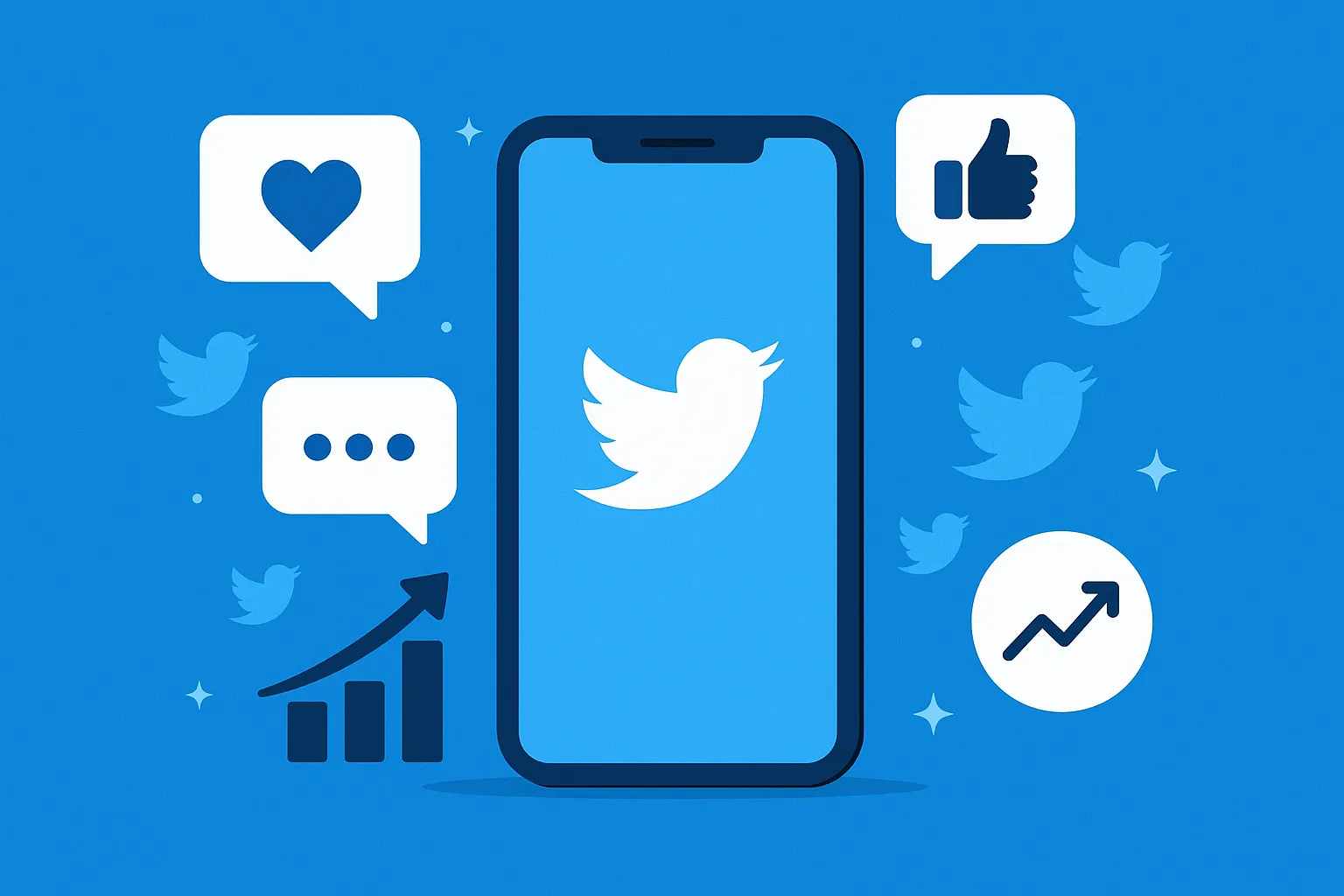Business Model of Twitter is one of the most influential social media platforms ever created. From breaking news to viral memes, it’s the go-to place for real-time updates and public conversations. But beyond the hashtags and trending topics, Twitter’s business model is a masterclass in monetizing attention at scale.
If you’re an entrepreneur or startup founder interested in building a social media platform, studying how Twitter generates revenue—and keeps users engaged—is essential. Its model combines advertising, premium subscriptions, and data licensing in ways that can inspire your own app strategy.
What is Twitter & How It Works
Twitter is a microblogging platform that lets users share short posts—originally limited to 140 characters, now expanded to 280—called tweets. It has become a global hub for real-time conversation, news dissemination, and cultural trends.
Here’s how Twitter works at a high level:
- Problem It Solves:
People want to share thoughts instantly, follow breaking news, and engage with communities in real time. Twitter solves this by offering a public platform for fast, concise updates. - Who Uses It:
Everyone from celebrities, journalists, and politicians to brands and everyday users. If you have something to say—or want to hear what others are saying—Twitter is the place. - How It work Operates:
Users create profiles and follow others. When you follow someone, their tweets appear in your timeline. You can reply, retweet (share), or like posts. Twitter also uses algorithms to surface recommended content and trending topics.
Twitter’s unique blend of brevity, public visibility, and real-time interaction has made it both a social network and an information platform—fueling its diverse revenue streams.
Read More : What is Twitter App and How Does It Work?
Target Audience Driving Twitter Revenue
Twitter’s user base is incredibly diverse, but it can be grouped into a few main segments:
- Everyday Consumers
Individuals who use Twitter to follow news, express opinions, or connect with friends and communities. - Influencers & Thought Leaders
Journalists, politicians, celebrities, and niche experts who rely on Twitter to broadcast messages and shape public conversation. - Brands & Businesses
Companies using Twitter for marketing, customer service, and brand awareness campaigns. - Developers & Researchers
Organizations and academics accessing Twitter’s data to analyze trends, build tools, or train AI models. - Advertisers
Brands and agencies that spend heavily on promoted content and targeted ads to reach highly engaged audiences.
This wide-ranging target audience is key to Twitter’s monetization strategy—especially in advertising and premium features.
Features that Support the Business Model
Twitter’s business success relies on features that drive engagement and revenue. Here are the core features powering its model:
- Promoted Tweets & Trends
Businesses pay to place their tweets or hashtags in front of targeted audiences, blending advertising seamlessly into user timelines. - Twitter Blue
A subscription service offering perks like editing tweets, longer posts, custom icons, and priority ranking in conversations. - Spaces
Live audio rooms that enable creators and brands to host conversations and events, attracting sponsorships and expanding user engagement. - Advanced Search & Analytics
Tools for advertisers and power users to track conversations, measure campaign impact, and refine targeting. - Tweet Deck & Scheduling
Professional tools for managing multiple accounts, scheduling posts, and monitoring mentions—popular with brands and agencies. - API Access & Data Licensing
Twitter monetizes access to its firehose of data for companies building products, AI models, or analytics solutions. - Verification & Priority Features
Subscription-based verification (the blue checkmark) now ties into monetization, offering higher visibility and credibility.
Each of these features supports either direct monetization (subscriptions, data licensing) or indirect monetization (advertising revenue through greater engagement).
Read More : Best Twitter Clone Scripts in 2025: Features & Pricing Compared
Revenue Streams of Twitter
Twitter has developed multiple income sources that blend advertising, subscriptions, and data monetization. Here’s a clear breakdown:
| Revenue Stream | How It Works |
| Advertising | Promoted tweets, promoted accounts, and promoted trends shown to targeted users. |
| Twitter Blue | Monthly subscription fee for premium features and tools. |
| Data Licensing | Selling access to historical and real-time tweet data via API. |
| Spaces Sponsorships | Brands sponsor live audio events hosted on Twitter Spaces. |
| Verification Subscriptions | Users pay to get verified status and priority visibility. |
| Partnership Revenue | Revenue from special partnerships and collaborations with broadcasters and content creators. |
Quick Details:
- Advertising
- The largest revenue driver.
- Brands target ads based on interests, demographics, and engagement.
- Includes video ads and dynamic product ads.
- The largest revenue driver.
- Twitter Blue
- Recurring monthly fees from users wanting extra features and customization.
- Recurring monthly fees from users wanting extra features and customization.
- Data Licensing
- Provides companies and researchers with large-scale data access for analysis and tools.
- Provides companies and researchers with large-scale data access for analysis and tools.
- Spaces Sponsorships
- Enables live, branded experiences to engage audiences in real time.
- Enables live, branded experiences to engage audiences in real time.
- Verification Subscriptions
- Pay-to-verify model that boosts visibility and user trust.
- Pay-to-verify model that boosts visibility and user trust.
These diverse revenue streams create a resilient model that balances advertising dependency with new subscription income.
Read more : Decoding X (Twitter): A Deep Dive into Its Revenue Streams and Business Model
Twitter’s Cost Structure in Detail
Running a platform as large and dynamic as Twitter involves substantial expenses. Here are the main cost categories that define Twitter’s cost structure:
- Infrastructure & Hosting
- Maintaining servers and cloud infrastructure to handle billions of tweets and requests daily.
- Ensuring platform stability, scalability, and speed globally.
- Maintaining servers and cloud infrastructure to handle billions of tweets and requests daily.
- Research & Development (R&D)
- Investing in new features like Spaces, subscriptions, and AI-powered recommendations.
- Constant updates to improve user experience and security.
- Investing in new features like Spaces, subscriptions, and AI-powered recommendations.
- Content Moderation & Trust & Safety
- Teams and technology dedicated to enforcing policies, combating misinformation, and keeping the platform safe.
- Teams and technology dedicated to enforcing policies, combating misinformation, and keeping the platform safe.
- Sales & Marketing
- Acquiring advertisers, promoting premium subscriptions, and driving user growth through campaigns.
- Acquiring advertisers, promoting premium subscriptions, and driving user growth through campaigns.
- Customer Support & Operations
- Assisting advertisers, enterprise clients, and everyday users with issues and account management.
- Assisting advertisers, enterprise clients, and everyday users with issues and account management.
- Compliance & Legal
- Managing privacy regulations, international laws, and data protection.
- Managing privacy regulations, international laws, and data protection.
- Employee Compensation
- Salaries, benefits, and incentives for thousands of employees, including engineering, product, legal, and support teams.
- Salaries, benefits, and incentives for thousands of employees, including engineering, product, legal, and support teams.
These costs are essential to maintain Twitter’s position as the real-time conversation leader—and they also inform how startup founders should plan their own budgets.
2024–2025 Innovations or Updates
Twitter has been evolving quickly to diversify revenue and improve user experience. Here are some of the most significant recent developments:
- Expanded Twitter Blue Features
- Longer posts up to 25,000 characters.
- Ad-reduction options.
- Monetization tools for creators.
- Longer posts up to 25,000 characters.
- Monetized Verification
- Paid verification now ties into increased reach and engagement benefits, changing how credibility and visibility work on the platform.
- Paid verification now ties into increased reach and engagement benefits, changing how credibility and visibility work on the platform.
- AI-Powered Recommendations
- Twitter has invested heavily in machine learning to improve timeline personalization and ad targeting.
- Twitter has invested heavily in machine learning to improve timeline personalization and ad targeting.
- Creator Subscriptions & Tips
- New revenue streams for influencers, enabling them to offer exclusive content and receive direct payments from followers.
- New revenue streams for influencers, enabling them to offer exclusive content and receive direct payments from followers.
- Spaces Discovery & Ticketed Events
- Enhanced discovery tools for Spaces and the option for hosts to charge entry fees to live audio events.
- Enhanced discovery tools for Spaces and the option for hosts to charge entry fees to live audio events.
- Integration with Financial Services
- Experimenting with payment tools and financial features to turn Twitter into a more versatile platform.
- Experimenting with payment tools and financial features to turn Twitter into a more versatile platform.
These updates are shaping Twitter into a hybrid of social network, creator marketplace, and subscription service—offering lessons for founders seeking sustainable monetization.
Takeaways for Startup Founders
Studying Twitter’s business model offers valuable insights if you’re planning to build your own social media platform or content-focused app. Here are the key lessons:
- Diversify Your Revenue Streams Early
Relying only on advertising can be risky. Subscriptions, premium features, and data services help smooth out revenue fluctuations. - Build Tools for Power Users and Creators
Power users (brands, journalists, influencers) generate significant engagement. Give them advanced tools—like scheduling, analytics, and monetization—to keep them loyal. - Invest in Trust & Safety
Content moderation, policy enforcement, and community guidelines aren’t optional. They protect your platform’s reputation and user experience. - Prioritize Real-Time Engagement
Features like Spaces and live events show how much value users place on immediacy and interaction. - Plan for Scalability
Even small apps can grow quickly if they tap into a cultural need. Your infrastructure should be ready to scale without compromising performance.
At Miracuves, we specialize in helping founders launch production-ready app clones inspired by proven platforms like Twitter. can save you time, reduce risk, and help you build a monetizable, scalable product from day one.
Read more : Reasons startup choose our twitter clone over custom development
Conclusion :
Twitter’s business model proves that combining real-time engagement, creator monetization, and data-driven advertising can build a sustainable and influential platform.
If you’re an entrepreneur dreaming of launching your own social media network, understanding Twitter’s strategies will help you avoid common pitfalls and unlock new opportunities.
Ready to bring your vision to life?
At Miracuves, we help founders like you launch fully customized, ready-made Twitter clone apps with robust monetization features, scalable infrastructure, and modern design.
Explore our Twitter Development Services and Contact Miracuves today to get started.
FAQs :
1. How does Twitter make most of its money?
Advertising remains Twitter’s primary revenue source. Promoted tweets, accounts, and trends are purchased by brands to reach targeted audiences. However, subscriptions and data licensing are growing contributors.
2. What is Twitter Blue, and why did Twitter introduce it?
Twitter Blue is a premium subscription offering extra features like longer posts, edit buttons, and reduced ads. It was introduced to diversify revenue beyond advertising and appeal to power users and creators.
3. How does Twitter monetize data?
Twitter sells access to its historical and real-time data via APIs. Companies, researchers, and developers pay for this data to build analytics tools, AI models, or monitor public sentiment.
4. What costs are involved in running a platform like Twitter?
Major costs include infrastructure hosting, R&D, content moderation, sales and marketing, compliance, and employee compensation. All are essential to maintain a reliable, scalable service.
5. Can I build a platform like Twitter for my own niche?
Yes. Many startups are creating niche social platforms targeting specific industries or communities. Working with an experienced development partner like Miracuves ensures you get scalable technology, robust features, and proven monetization tools right from the start.
Related Articles :








